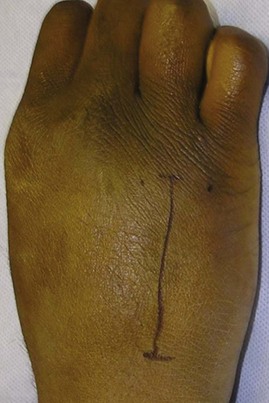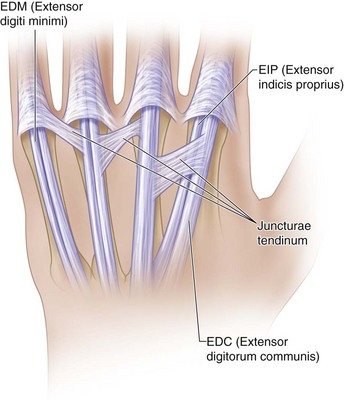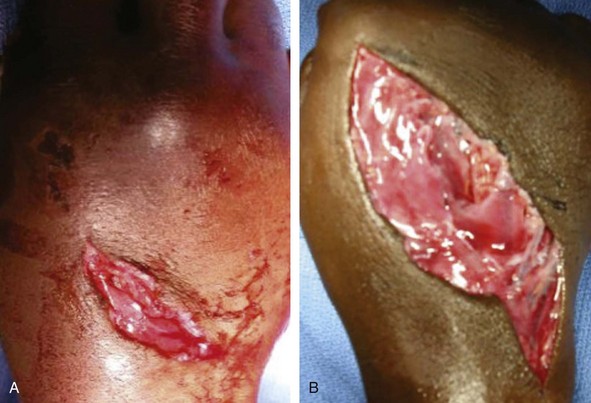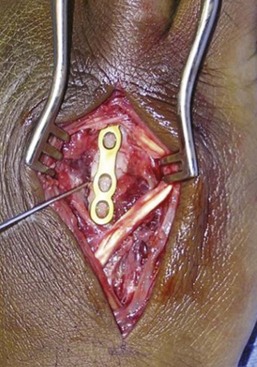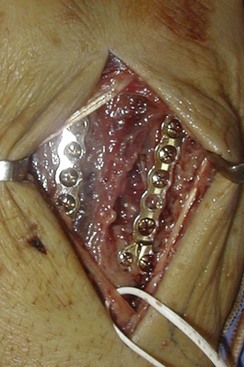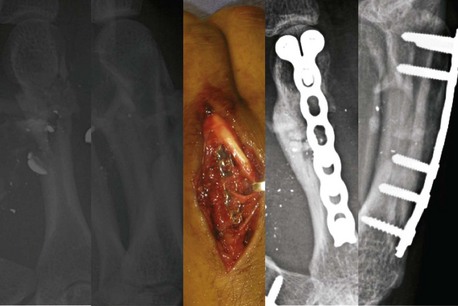Procedure 55 Metacarpal Shaft Fractures
![]() See Video 39: Metacarpal Shaft Fractures
See Video 39: Metacarpal Shaft Fractures
Examination/Imaging
Clinical Examination
 Note swelling and bruising over the dorsum of the hand.
Note swelling and bruising over the dorsum of the hand.
 Multiple metacarpal fractures predispose to compartment syndrome of the hand.
Multiple metacarpal fractures predispose to compartment syndrome of the hand.
 Look carefully for any wounds—may indicate an open fracture.
Look carefully for any wounds—may indicate an open fracture.
 Look carefully for rotational deformity with fingers flexed as much as possible and compare with opposite hand.
Look carefully for rotational deformity with fingers flexed as much as possible and compare with opposite hand.
 Ensure circulation is adequate by checking capillary refill.
Ensure circulation is adequate by checking capillary refill.
 Test and document digital sensation.
Test and document digital sensation.
 Ask patient to flex and extend the interphalangeal joints within limits of pain to confirm continuity of flexor and extensor tendons.
Ask patient to flex and extend the interphalangeal joints within limits of pain to confirm continuity of flexor and extensor tendons.
Surgical Anatomy
 Metacarpals can be easily accessed through the dorsal approach (Fig. 55-1).
Metacarpals can be easily accessed through the dorsal approach (Fig. 55-1).
 Dorsal cutaneous nerves and veins are located in the subcutaneous plane and must be identified and preserved.
Dorsal cutaneous nerves and veins are located in the subcutaneous plane and must be identified and preserved.
 The extensor tendons are surrounded by paratenon and can be easily separated by dividing the juncturae tendinum that interconnect them at the level of the metacarpal necks (Fig. 55-2).
The extensor tendons are surrounded by paratenon and can be easily separated by dividing the juncturae tendinum that interconnect them at the level of the metacarpal necks (Fig. 55-2).
Positioning
 The patient is positioned supine with the arm on a hand table.
The patient is positioned supine with the arm on a hand table.
 The surgeon is seated on the cephalad side of the table with the forearm pronated to allow access to the dorsum of the hand.
The surgeon is seated on the cephalad side of the table with the forearm pronated to allow access to the dorsum of the hand.
Exposures
 A longitudinal incision is marked along the dorsum of the metacarpal. The incision is centered over the fracture and equals the length of the plate.
A longitudinal incision is marked along the dorsum of the metacarpal. The incision is centered over the fracture and equals the length of the plate.
 In open injuries, the open wound is incorporated in the incision and excised as needed.
In open injuries, the open wound is incorporated in the incision and excised as needed.
 For fixation of multiple fractures, two incisions on the dorsum in the second and fourth web space will provide access to adjacent metacarpals and allow decompression of the interosseous compartments if needed. Alternatively, a transverse incision across the back of the hand may be used as an extension of a preexisting traumatic wound (Fig. 55-3).
For fixation of multiple fractures, two incisions on the dorsum in the second and fourth web space will provide access to adjacent metacarpals and allow decompression of the interosseous compartments if needed. Alternatively, a transverse incision across the back of the hand may be used as an extension of a preexisting traumatic wound (Fig. 55-3).
 After spreading dissection, the extensors are exposed and retracted (Fig. 55-4).
After spreading dissection, the extensors are exposed and retracted (Fig. 55-4).
 The periosteum at the fracture site is elevated circumferentially to allow accurate reduction and remove any interposed soft tissue.
The periosteum at the fracture site is elevated circumferentially to allow accurate reduction and remove any interposed soft tissue.
Pearls
For plating of adjacent metacarpals, a single skin incision between the metacarpals will allow access to both fractures (Fig. 55-5).
Careful spreading dissection is necessary after skin incision to preserve subcutaneous nerves and veins.
Paratenon around the extensor tendons must be preserved to minimize postoperative tendon adhesions.
Juncturae tendinum between tendons may need to be divided to facilitate retraction of the extensor tendons.
In case of excessive comminution, periosteum around the fracture is left intact, and the implant is secured distally and proximally. Figure 55-6 shows the bridge plating technique used in a comminuted metacarpal fracture due to a gunshot wound.
Procedure
Step 1: Principles and Methods of Fixation
 In oblique and spiral fractures, achieve provisional reduction and stabilize with a K-wire (Fig. 55-7).
In oblique and spiral fractures, achieve provisional reduction and stabilize with a K-wire (Fig. 55-7).
 Temporary fixation of transverse fractures is not usually possible. After a trial reduction is performed, proceed with fixation of the plate to one fragment.
Temporary fixation of transverse fractures is not usually possible. After a trial reduction is performed, proceed with fixation of the plate to one fragment.
 Type of fixation depends on the fracture geometry.
Type of fixation depends on the fracture geometry.
 Transverse fractures are treated with compression plating (Fig. 55-8).
Transverse fractures are treated with compression plating (Fig. 55-8).
 Short oblique fractures are held with reduction forceps and stabilized with a lag screw. The fixation is then reinforced with a contoured plate without additional compression through the plate (neutralization plate). If the plane of the fracture allows insertion of the lag screw through the plate, this is preferred.
Short oblique fractures are held with reduction forceps and stabilized with a lag screw. The fixation is then reinforced with a contoured plate without additional compression through the plate (neutralization plate). If the plane of the fracture allows insertion of the lag screw through the plate, this is preferred.
Stay updated, free articles. Join our Telegram channel

Full access? Get Clinical Tree















